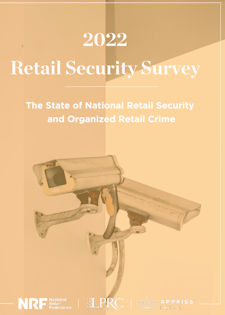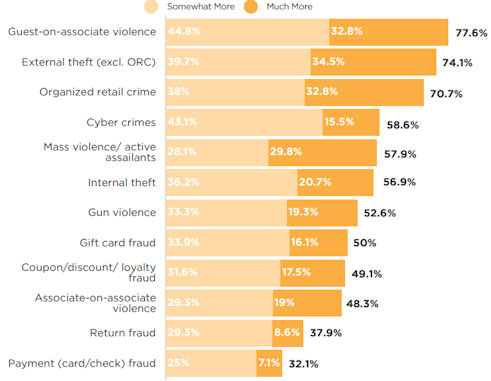NRF Reports Retail Shrink Nearly
a $100B Problem
2022 National Retail Security Survey released today
by the National Retail Federation
September 14, 2022 -- WASHINGTON - Retail shrink, when taken as a
percentage of total retail sales in 2021, accounted for $94.5 billion in
losses last year, up from $90.8 billion in 2020, according to the
2022 National Retail Security Survey released today by the National
Retail Federation. Organized retail crime (ORC), a critical component of that
shrink, is a growing challenge both for retailers and the industry at large.
"The factors contributing to retail shrink have multiplied in recent years, and
ORC is a burgeoning threat within the retail industry," NRF Vice
President for Research Development and Industry Analysis Mark Mathews said.
"These highly sophisticated criminal rings jeopardize employee and customer
safety and disrupt store operations. Retailers are bolstering security efforts
to counteract these increasingly dangerous and aggressive criminal activities."
The survey found that the average shrink rate in 2021 was 1.44%, a slight
decrease from the last two years but comparable to the five-year average of
1.5%. The majority of retailers report that in-store, ecommerce and omnichannel
fraud have risen. Violence is a growing area of concern and retailers are
prioritizing addressing guest-on-associate violence, external theft and ORC.
Increase in Risk and Threat Priorities over
the Past Five Years
The COVID-19 pandemic created more challenges for retailers. A large majority (87.3%)
of respondents said the pandemic resulted in an increase in overall risk for
their organization. Retailers specifically cited an
increase in violence (89.3%), shoplifting (73.2%), ORC and employee theft
(tied at 71.4%) as a result of the pandemic.
Retailers reported a 26.5% increase in ORC, on average. Even more
alarming, the vast majority (81.2%) said the violence and aggression associated
with ORC increased in the past year.
Research shows that ORC groups commit retail crimes for their financial benefit,
and specifically target items that are concealable, removable, available,
valuable, enjoyable and disposable, also known by the acronym CRAVED. Items that
have more of these characteristics are more likely to be stolen. The top
categories targeted include apparel, health and beauty, electronics/appliances,
accessories, food and beverage, footwear, home furnishings and housewares, home
improvement, eyewear, office supplies, infant care and toys.
The top five cities/metropolitan areas affected by ORC in the past year were
Los Angeles, San Francisco/Oakland, New York, Houston and Miami.
Retailers are prioritizing new resources to safeguard their customers, employees
and operations, with nearly half (44.5%) indicating loss prevention as an
area of investment. More than half (60.3%) are increasing their technology
budget and 52.4% are increasing their capital and equipment budget. As part of
these efforts, many are investing in various technologies, including RFID,
computer vision at point of sale and license plate recognition.
"Reducing instances of violent crime, particularly those affiliated with ORC,
is a key priority among retailers because it directly and immediately impacts
employees in numerous capacities," Loss Prevention Research Council Senior
Research Scientist Cory Lowe said. "In many cases, it is difficult to measure
the full extent of these crimes without being investigated internally and in
coordination with law enforcement."
As retailers implement additional measures to diminish and ultimately prevent
ORC-related incidents from occurring, policy reform is still needed. A majority
of respondents (70.8%) reported an increase in ORC where felony thresholds
have increased. Retailers desire stronger ORC legislation, especially at the
federal level, as well as better enforcement of existing laws.
The 2022 National Retail Security Survey was conducted online among senior loss
prevention and security executives in the retail industry. The study was done in
partnership with the Loss Prevention Research Council and is sponsored by
Appriss Retail.
Click
here to view the report.
About NRF
 The
National Retail Federation, the world's largest retail trade association,
passionately advocates for the people, brands, policies and ideas that help
retail thrive. From its headquarters in Washington, D.C., NRF empowers the
industry that powers the economy. Retail is the nation's largest private-sector
employer, contributing $3.9 trillion to annual GDP and supporting one in four
U.S. jobs - 52 million working Americans. For over a century, NRF has been a
voice for every retailer and every retail job, educating, inspiring and
communicating the powerful impact retail has on local communities and global
economies. nrf.com
The
National Retail Federation, the world's largest retail trade association,
passionately advocates for the people, brands, policies and ideas that help
retail thrive. From its headquarters in Washington, D.C., NRF empowers the
industry that powers the economy. Retail is the nation's largest private-sector
employer, contributing $3.9 trillion to annual GDP and supporting one in four
U.S. jobs - 52 million working Americans. For over a century, NRF has been a
voice for every retailer and every retail job, educating, inspiring and
communicating the powerful impact retail has on local communities and global
economies. nrf.com
About the LPRC
 The
Loss Prevention Research
Council was founded in 2000 by leading retailers and Dr. Read Hayes, an NRSS
co-founder, in an effort to support the evidence-based needs of loss prevention
decision-makers. To date, the LPRC has conducted over 300 studies with retailers
and other research partners. The LPRC strives to provide comprehensive research,
development opportunities, and collaborative spaces for our members that will
enable the innovation of retail loss and crime control solutions.
The
Loss Prevention Research
Council was founded in 2000 by leading retailers and Dr. Read Hayes, an NRSS
co-founder, in an effort to support the evidence-based needs of loss prevention
decision-makers. To date, the LPRC has conducted over 300 studies with retailers
and other research partners. The LPRC strives to provide comprehensive research,
development opportunities, and collaborative spaces for our members that will
enable the innovation of retail loss and crime control solutions.
&uuid=(email))



